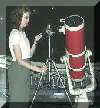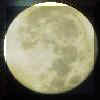Animations
DIGITAL CAMERAS, SCOPES & LENSES
Hand Lenses, Magnifiers, Spotting Scopes, Microscopes, and Telescopes
While you can use a mobile device's digital camera by itself and find it quite useful, it also makes a great addition to any tool that you use to improve your ability to see, such as magnifying glasses, spotting scopes, binoculars, microscopes, and telescopes. The main accessory you need to take effective digital images with these scopes is a tripod with a phone clamp. A good tripod that is easy to position will allow you to integrate the digital camera with most of your other optical instruments. Trying to focus the scope along with the camera can be challenging (after all how many hands do you have?). Also it is important to remember that when using some form of scope or lens system, you turn off the camera's flash. It's always a good idea that whenever you use a digital camera with any form of scope to use an outside power adapter for the camera. The LCD screens use a lot of battery power, and when on batteries most cameras will regularly turn themselves off after a few minutes when they are not taking pictures.
SPOTTING SCOPES, BINOCULARS, & MONOCULARS:
Using a digital camera with a spotting scope you just put the camera lens right up to the rubber gasket of the scope, and then focus the scope's lens. Use the display screen of the camera to check your image. It is possible to hold the scope over the lens while holding the camera, but again the use of a tripod for both the scope and the camera makes it much easier.
This image of nesting owls was captured from the second floor across a parking lot using a spotting scope and a relatively inexpensive digital camera. This image of a right whale was taken on a whale watching boat off the coast of Connecticut using a Casio QV10 and a monocular.
MICROSCOPES
When using a digital camera with a microscope always position the digital camera on a tripod. First use your eyes and the microscope to find and focus on an object, then position the digital camera over the eyepiece and move the camera or scope until you can see the image on the camera's screen. Lighting an object from above or outside usually works better than using the lighted stage. This is because the amount of light coming from under your object shining right up into the camera causes a whiting or flare effect, making it actually harder to see your object. You also may want to create a light shield from a paper towel tube, old film can, or foil to prevent light from reflecting off the surface of the eyepiece lens and into the camera. A great option on some cameras is a live video out feature that allows you to display not only on the small LCD screen on the back of the camera but also onto any television (through an RCA jack) or video projector.
TELESCOPES
When using a digital camera with a telescope, again, always position the digital camera on a tripod. Line up your scope, view and focus the telescope using your eyes (if you wear glasses, do your focusing with them on). Once you have an object in focus, position the digital camera over the eyepiece (you may need to move it back a bit, depending on the type of eyepiece). When the object is centered in the LCD screen, just push the shutter to capture the image. If your camera supports a remote shutter switch, then use the remote to reduce motion of the camera, or shaking of the telescope.
This image of the moon was captured using a Casio 780 (fixed focus) and a Newtonian telescope (see above)
click to enlargeThis picture of Jupiter and its moons was also captured using the Casio 780 and a Newtonian telescope.
click to enlarge















